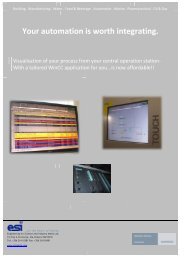ESI Oil and Gas Brochure - Engineering for Science and Industry ...
ESI Oil and Gas Brochure - Engineering for Science and Industry ...
ESI Oil and Gas Brochure - Engineering for Science and Industry ...
Create successful ePaper yourself
Turn your PDF publications into a flip-book with our unique Google optimized e-Paper software.
Instead of avoiding<br />
their ignition by<br />
explosion protection<br />
measures, it is<br />
preferable to<br />
detect flammable<br />
gases be<strong>for</strong>e they<br />
become ignitable.<br />
Flammable gas detection technologies<br />
Most explosion hazards arise from flammable gases <strong>and</strong> vapours. Instead of avoiding their<br />
ignition by explosion protection measures, it is preferable to detect them be<strong>for</strong>e they become<br />
ignitable. The transmitter is a gas detector that continuously monitors flammable gases <strong>and</strong><br />
vapours in the ambient air. The gas concentration that is detected in a range lower than the<br />
Lower Explosive Limit (100% LEL) is converted to an industry st<strong>and</strong>ard 4 to 20 mA signal. Central<br />
controllers <strong>and</strong> control panels are used to evaluate the signal <strong>and</strong> activate automatic counter<br />
measures <strong>and</strong> alarm devices according to the pre-programmed cause <strong>and</strong> effect matrices.<br />
Flame <strong>and</strong> heat detection<br />
Image courtesy of Dräger<br />
There is no such thing as a perfect flame detector. All have their own strengths<br />
<strong>and</strong> limitations. The correct application of detection technology is key to<br />
effective detection. There are four detector options available with <strong>ESI</strong>:<br />
❚ Infra Red Flame Detectors (IR)<br />
❚ Ultra Violet Flame<br />
Detector (UV)<br />
❚ Combined UV & IR Detector<br />
❚ Visual flame detection<br />
Visual flame detection was<br />
developed out of a need to<br />
create a detector that was<br />
spatially aware, allowing <strong>for</strong> the<br />
ability to discriminate between<br />
a large number of small sources<br />
Fire & <strong>Gas</strong> Detection<br />
within its field of view <strong>and</strong><br />
one relatively large, bright<br />
event. The application behind<br />
this requirement was FPSOs.<br />
The areas that are adjacent<br />
to the process relief flare<br />
need protection. Flaring has<br />
caused numerous shutdowns<br />
by conventional radiation<br />
flame detectors because they<br />
are unable to discriminate<br />
between the two events.



